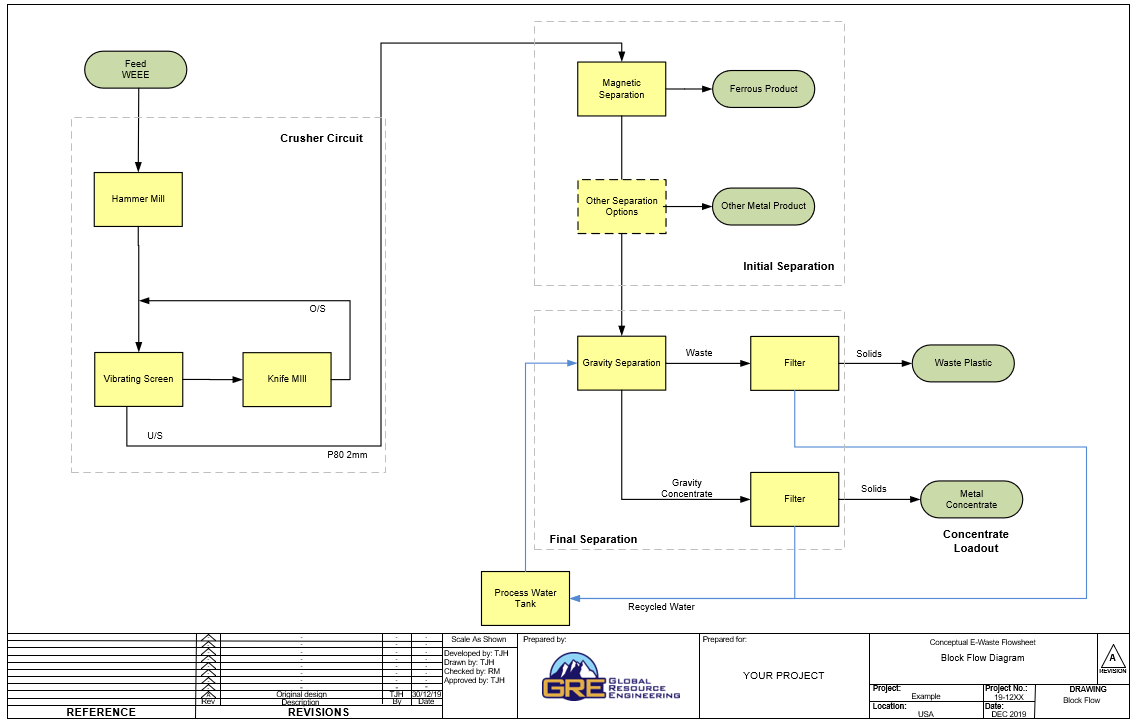Table of Contents
Electronic Waste Recycling An Overview
Like most mining ventures under taken by amateurs, processing e-waste can be a quick way to loss all your money. It seems easy, there is a lot of e-waste available with no real pathway for recycling beyond the existing scrap yards. There is a growing trend of people entering this business with little to no experience in recycling, materials handling, metals recovery or for that matter business.
At 911Metallurgist we are here to help. We have the experience required to develop a process for any number of e-waste streams but we will focus you on the high value, lowest effort approach first. People enter this market thinking they are going to recover every last oink from the pig – plastics, steel, aluminum, silica, etc. when in fact the intrinsic value of e-waste on a per unit basis (one computer) is very low – less than $US 3 each. There is a lot of material that has to be processed to cover costs let alone provide some profit. Our approach is one commonly held in mining (our backgrounds) “tons are worth more than grade.” We target the highest value materials, maximize recovery and minimize capital investment. We can design modular systems that can be expanded easily in both capacity and additional metal recoveries as required.
This document provides some highlights of what can be done in terms of recycling e-waste in particular electronic devices such as computers to recover the valuable metals contained in them. We have provided an overview of the sources of e-waste, their value and an approach to recycling the highest value components.
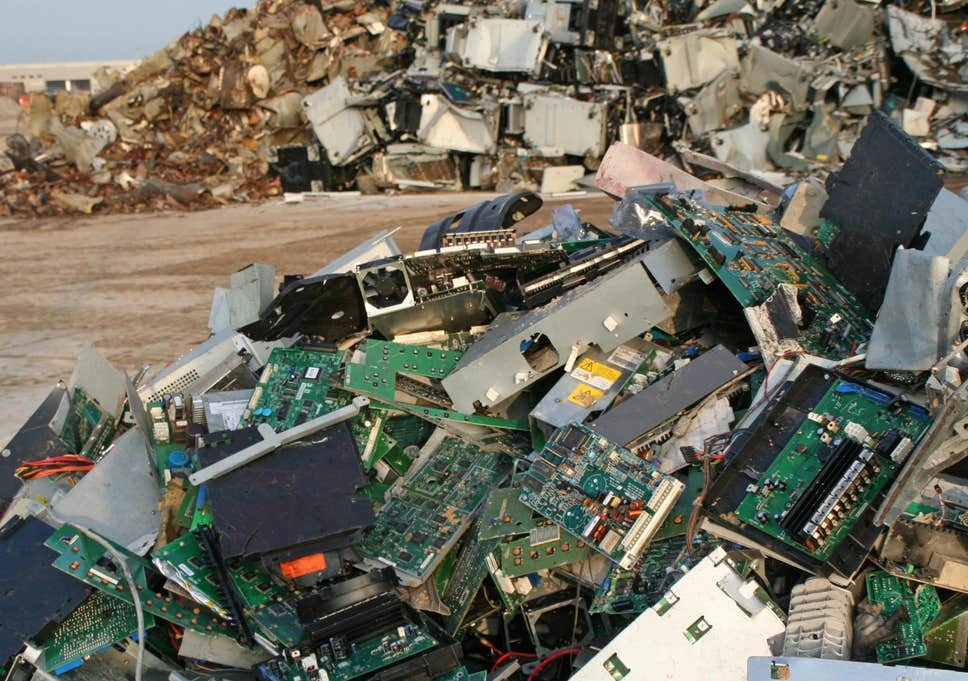
E-Waste – Growth
As the world becomes more globalized; with higher levels of disposable incomes, urbanization, and industrialization and increasing amount of electrical and electronic equipment is being utilized. As part of this growth comes the corollary of the now having to deal with an unprecedented amount of electronic waste (e-waste) that 30 years ago did not exist.
The United Nations University (UNU) commissioned a recent study (2017) that shows that the amounts of e-waste continue to grow, while too little is recycled. In 2016, 44.7 million metric tonnes (Mt) of e-waste was generated and only 20% was recycled. This despite the fact that 66% of the world’s population is now governed by e-waste legislation.
Discarded equipment, such as phones, laptops, desktops, routers, switches and TVs contain substances that pose considerable environmental and health risks, especially if treated inadequately. Most e-waste is not properly documented and not treated through appropriate recycling chains and methods. At the same time, e-waste streams challenge the efforts towards a recycling economy as valuable and scarce resources are wasted.
E-Waste Sources
The countries of the world combined generated a staggering 44.7 million metric tonnes (Mt), or an equivalent of 6.1 kilogram per inhabitant (kg/inh), of e-waste annually in 2016, compared to the 5.8 kg/inh generated in 2014. The amount of e-waste is expected to increase to 52.2 million metric tonnes, or 6.8 kg/inh, by 2021. Globally, only 8.9 Mt of e-waste are documented to be collected and recycled, which corresponds to 20% of all the e-waste generated.
In 2016, Asia was the region that generated by far the largest amount of e-waste (18.2 Mt), followed by Europe (12.3 Mt), the Americas (11.3 Mt), Africa (2.2 Mt), and Oceania (0.7 Mt). While the smallest in terms of total e-waste generated, Oceania was the highest generator of e-waste per inhabitant (17.3 kg/inh), with only 6% of e-waste documented to be collected and recycled. Europe is the second largest generator of e-waste per inhabitant with an average of 16.6 kg/inh; however, Europe has the highest collection rate (35%). The Americas generate 11.6 kg/inh and collect only 17% of the e-waste generated in the countries, which is comparable to the collection rate in Asia (15%). However, Asia generates less e-waste per inhabitant (4.2 kg/inh). Africa generates only 1.9 kg/inh and little information is available on its collection rate.
The value of this material totaled a staggering $US 62 billion based on 2016 quantities.
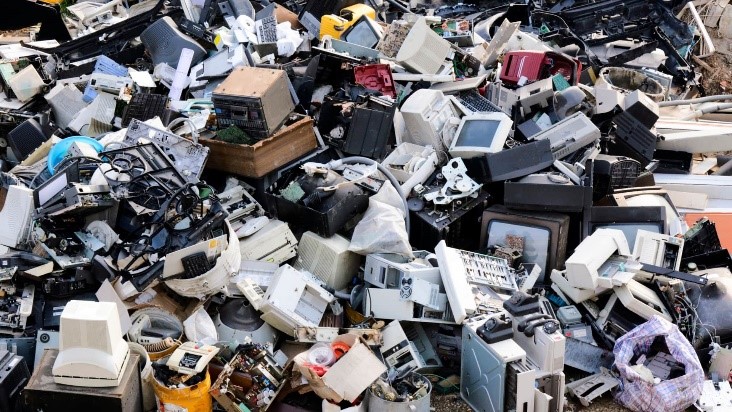
(source https://news.itu.int/new-un-coalition-to-tackle-electronic-waste/)
E-waste is a broad category of disposed electronics and includes six categories:
- Temperature exchange equipment, more commonly referred to as cooling and freezing equipment. Typical equipment includes refrigerators, freezers, air conditioners, heat pumps.
- Screens, monitors. Typical equipment includes televisions, monitors, laptops, notebooks, and tablets.
- Lamps. Typical equipment includes fluorescent lamps, high intensity discharge lamps, and LED lamps.
- Large equipment. Typical equipment includes washing machines, clothes dryers, dish-washing machines, electric stoves, large printing machines, copying equipment, and photovoltaic panels.
- Small equipment. Typical equipment includes vacuum cleaners, microwaves, ventilation equipment, toasters, electric kettles, electric shavers, scales, calculators, radio sets, video cameras, electrical and electronic toys, small electrical and electronic tools, small medical devices, small monitoring and control instruments.
- Small IT and telecommunication equipment. Typical equipment includes mobile phones, Global Positioning Systems (GPS), pocket calculators, routers, personal computers, printers, telephones.
Many large recycling facilities are already established to deal with the larger electric equipment such as appliances and electric motors. This type of electric waste material is not new, but its quantity is increasing due to increasing standards of living. It is the true electronic waste (computers, phones, etc) that currently has no defined organized recycling pathway. This material is classified as Waste Electrical and Electronic Equipment (WEEE).
Information and Communication Technology Sources
Today over half the world’s population is using the internet, that is 3.6 billion people all being able to get online. To facilitate this advancement and to fuel even greater internet reach requires extensive infrastructure development. The backbone of the internet is electronic equipment that has a relatively short lifecycle. The lifecycle is not short because of the equipment durability but rather a function of becoming outdated quickly. To push more data down the same cable requires new technology and new switches and routers are cheaper and easier to install than new cabling. Where does the old equipment go – mostly to landfills.
Also, there has been an even bigger growth in cellular phone use. There are now an estimated 7.7 billion mobile cellular subscriptions and 4.2 billion active mobile-broadband subscriptions. Over 80% of the world’s population is covered by a mobile broadband signal. 54% of households have Internet access at home and 48% have a computer (International Telecommunication Union).
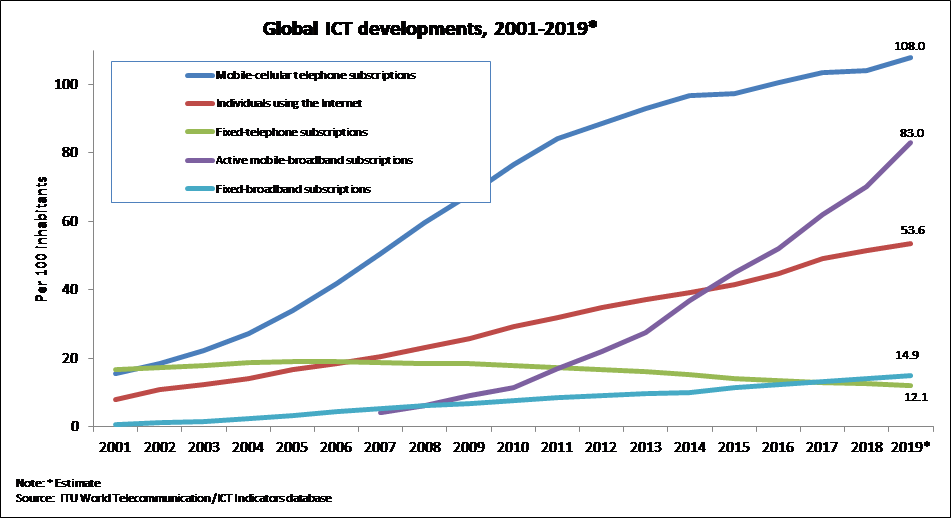
In the developed world the grow is also fueled by the use of multiple connected devices by single users. Between 2012 and 2015, the number of Americans who owned a smartphone, a computer, and a tablet doubled to 36% of adults (Anderson 2015 https://www.pewresearch.org/fact-tank/2015/11/25/device-ownership/):
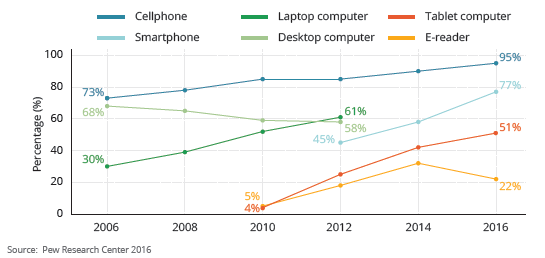
E-Waste – The New Urban Mine
A wide variety of valuable materials are contained in electric and electronic appliances. Up to 60 elements from the periodic table can be found in complex electronics, and many of them are recyclable. Large appliances have been successfully recycled for many years. They contain large amounts of low value materials like iron that require volume handling and treatment such as a traditional scrap yards offer.
E-waste contains precious metals including gold, silver, copper, platinum, and palladium, but it also contains valuable bulky materials such as iron and aluminum, along with plastics that can be recycled. The UNU estimates that the resource perspective for secondary raw materials of e-waste is worth $USD 62 billion of raw materials. It is these high value low volume recyclables that present the highest potential for new recovery methods.
Based on UNU estimates, the intrinsic value of precious metals and plastics contained in a mobile phone of an average weight of 90 grams is $US 2.25 per piece. The raw material value is relatively small compared to the second-hand or new price. In 2016, it was estimated that around 435 kilotons of waste mobile phones were generated across the globe. The value of the raw materials in wasted mobile phones was $US 10 Billion.
The largest and easiest market to penetrate with a new recycling program is that of computers and electronic accessories. Those devices that don’t contain screens. Dealing with LCD, plasma or conventional CRT systems requires special care because of the environmental risk associated with handling these items. Many of these screens contain mercury and other deleterious elements. Our goal is to provide information on how to develop a recycling system for the highest value components such as copper, gold, silver, platinum, palladium, etc.
A study by Van Eygen et al wrote a paper outlining the intrinsic recyclable value of both a desktop and laptop computer. The data in the table below is based on a 1000 kg sample of desktop and laptop computers. Average weights for the devices under consideration (see Section 2.2.1) were used: 12.33 kg for the desktop PC tower and 2.84 kg for the laptop (Chancerel and Rotter, 2009),
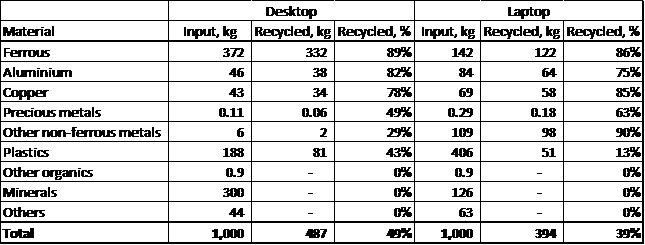
According to the EPA, for every million cell phones we recycle, 15,875 kg of copper, 350 kg of silver, 34 kg of gold, and 15 kg of palladium can be recovered. That is a metal value of $2.63 per computer (using Dec 2019 prices). That is not a lot of value to be working with so your approach to recovery has to be robust and inexpensive.
Circuit boards and batteries contain a higher concentration of metals. It has been reported (Veldhuizen and Sippel, 1994) that one metric ton of circuit boards can contain between 80 and 1,500 g of gold and between 160 and 210 kg of copper. Obviously if you can just harvest circuit boards you are going to have a much higher value product to work with but someone has to do the initial separation from the equipment it came in.
Hopefully this information has illustrated that despite the high global value of e-waste, the intrinsic value is relatively low. We need to keep in mind that the only successful recycling program is one that makes money and use that to guide our approach. It must be green in every sense of the word.
Recycling Methods
The recycling of e-waste is becoming mandatory in more countries every year. The issue is the hazardous materials that some of these components contain. Our experience has shown that most people entering this market recognize this and tend to stick with the higher value less environmentally sensitive materials like computers and their peripheries. Phones can also be a good source of materials but it is recommended that the screens be recycled at a specialty facility and only the printed circuit boards be processed (PCB). The real value in any electronic is the PCB components.
There are a large number of publications related to e-waste recycling including text books, websites, peer-reviewed papers but none of these provides a pathway to a process that is efficient and economic. Our goal at 911Metallurgist is to provide the guidance you need to develop a resilient processing method through, our experience, test work and design engineering. The following is a summary of several recycling areas we have examined in the recent past:
- Printed-circuit board metal recycling
- Whole computer recycling
- Scrap metal recovery from incinerator bottom ash
- Zorba processing (is the collective term for shredded and pre-treated non-ferrous scrap metals, most usually originating from End-of-Life Vehicles (ELVs) or Waste Electrical and Electronic Equipment (WEEE). The specifications for Zorba were established by the Institute of Scrap Recycling Industries (ISRI) in the U.S., which defines Zorba as a ‘shredded mixed non-ferrous metals consisting primarily of aluminum generated by eddy-current separator or other segregation techniques’.)
There are many methods to process WEEE including physical separations, pyrometallurgy and hydrometallurgy or combinations of these. Many of these methods were developed with high metal recovery in mind. Although, that seems like the ideal approach, each recovery step costs in terms of both capital and operating costs for the equipment. The goal is to balance the recovery efficiency with the cost of recovery. The approach described here one commensurate with the value of the material being treated.
Initial Separation
In the vast majority of methods some form of size reduction is going to be required to win the metals from the WEEE. The exception to this would be the use of pyrometallurgy or direct smelting of the components. Direct smelting, incineration and other pyrometallurgical methods have not bee used for primary treatment mainly because the quantity of metals is not high enough to make it economically viable and there is the issue of burning plastic components.
A variety of equipment can be employed for size reduction and this depends primarily on the following variables:
- Size of the material to be processed – whole computers vs PCB for example
- Hardness of the materials
- Capacity required
- Product size required
In general, a hammer mill, knife mill or shredder can be employed. Multiple stages of size reduction may be required depending on your downstream processing methods.
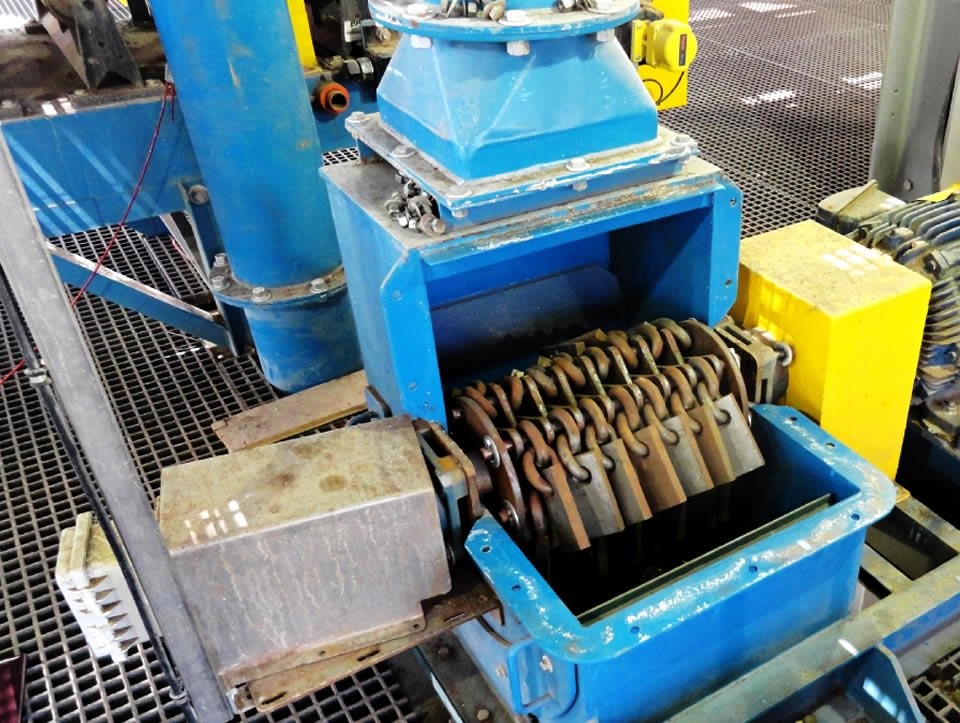
Hammer Mill (https://feeco.com/hammer-mills/)
Initial Separations
A wide variety of options are available for the first stage metal recovery and the choice of these depends heavily on the value of the components, the recovery efficiency and the cost of recovery. The first stage separation can include any combination of the following:
- Magnetic Separation – to remove ferrous components such as heat shields and cases. This can be done after an initial size reduction or after final size reduction or omitted completely. The equipment can be a cross belt magnet, a permanent magnet, or a dry/wet magnetic drum separator (high intensity or low intensity). See this link for more details https://www.911metallurgist.com/magnetic-separation-method
- Eddy Current Separation – to remove the non-ferrous metals from other components by inducing an electromagnetic field in the materials. This separation system was developed primarily for aluminum recovery but has a wide array of other applications now. See this link for more details https://www.911metallurgist.com/equipment/eddy-current-aluminium-separation/
- Electrostatic Separation – induces a static charge in materials to cause them to be separable from other components. This equipment was originally developed for use in iron ore separation to remove silica impurities. It can be used to remove plastics, silica and other materials from metals. See this link for more details https://www.911metallurgist.com/electrostatic-separation/
Most of the above processes are conducted dry. In these processes water interferes with the transfer of a charge or the induction of a magnetic field. The one exception is wet drum magnetic separation. Dry processing has the advantage of not requiring and drying of the products after treatment and no water consumption or recycle. However, water is a very dynamic fluid and promotes better separations when using gravity methods.
Final Separations
In our experience, the use of the initial separations is not generally warranted for the treatment of WEEE as the recovered value is too low. However, in some cases, for example the removal of ferrous materials, a separation may be required for reasons of penalty elements (more later).
In general, for the treatment of WEEE we recommend targeting the production of a single high-quality concentrate that contains copper and the precious metals. This concentrate can be sold directly to a downstream refinery such as those shown here:
https://www.thebalance.com/the-20-largest-copper-refineries-2339744
Most of the heavier metals can be recovered in one concentrate using a gravity system. In one recent process we worked on we recovered over 70% of the valuable metals in a single pass gravity system:
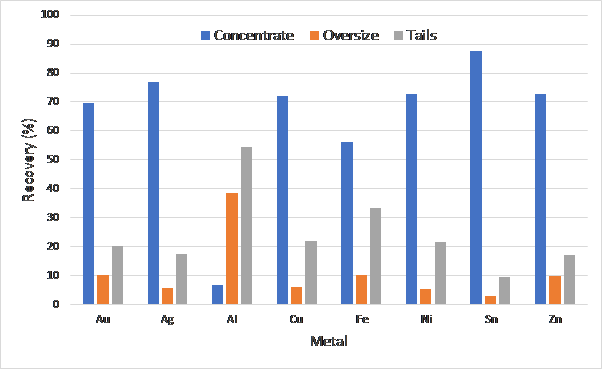
This process was developed for the treatment of computer waste (WEEE) and based on a single pass treatment system with not oversize reduction. The material was initially reduced in size with a primary hammer mill, subjected to magnetic separation to remove heat shields and then further educed in size with a second knife mill. The product was reduced to 80% pass 2 mm. The fine material was combined with water and then subjected to a gravity separation system. The results of the single pass system are shown in the above graph.
Test work was conducted to confirm all aspects of the flowsheet before undertaking the engineering design for the process. The equipment required for a process that is capable of handling 5 tonnes per hour costs approximately $US 100,000 and is based on the following flowsheet:
